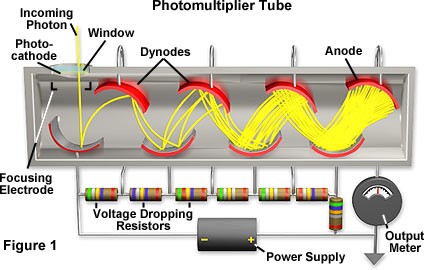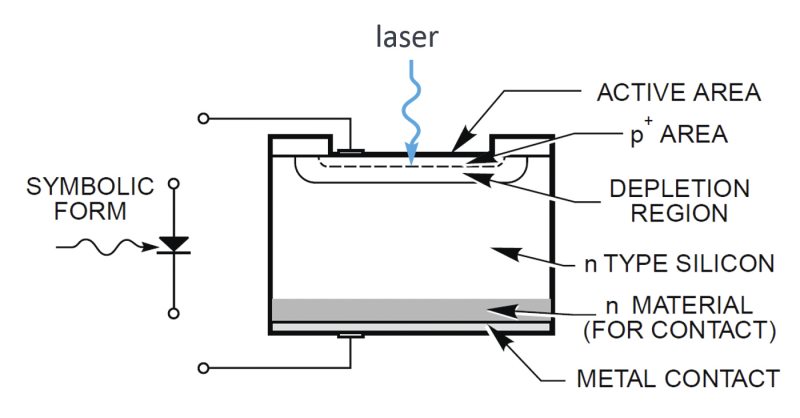Having the proper detector is just as important (if not more so) as having the proper laser source. Determining which type of detector best suits one’s needs is essential to successfully report the most representative measurement. One must always be mindful of the wavelength and power of the source with respect to the limits of the detector being used. Always check the datasheet to ensure the detector will be safely operable given the laser source specifications. While consulting the manual is essential, sometimes one can have an idea if a detector will be a possible choice based simply on its material. For instance, silicon detectors are typically good for visible wavelengths, but one would usually be better served with an InGaAs or a Ge detector for wavelengths in the infrared. This blog post gives a cursory overview of detector types and operation.
Thermal Detector
With thermal detectors, optical power gets transformed into heat and converted into an electrical signal. Thermal detectors preceded photon detectors. Thermal detectors tend to have a lower detectivity and a slower response time than photon detectors. However, an advantage is that most thermal detectors do not require cooling. There are several sub-types of thermal detectors including thermophile detectors, and pyroelectric detectors as follows.
Thermophile Detector
Thermophile detectors are commonly used for detecting infrared radiation. These detectors use the same concept as thermocouples. Thermocouples (and thermophile detectors) are made of two different metals where one of the metals is blackened to absorb radiation. The temperature increase due to the absorbed radiation at the blackened junction creates a voltage. This generated voltage is related to the power incident on the detector. The response of thermophile detectors is not influenced much by the beam size or position. Because of the slow detector response time (which can be on the order of seconds), they are typically used for power measurements of continuous wave or quasi-continuous wave sources.
Pyroelectric Detector
Pyroelectric detectors are usually used in the infrared range, though some have been developed to detect into the terahertz wavelengths including into some of the microwave region. They are more sensitive than thermophiles and can be used for weak light. These types of detectors take advantage of the asymmetry in pyroelectric crystal structure. The polarization of pyroelectric crystals changes with temperature. When incident radiation heats up the crystal, the charge changes and gets turned into a signal voltage by an operational amplifier. It is important to note that the noise in pyroelectric detectors decreases with frequency. Depending on the wavelength or power of the source, a chopper or filter may need to be used between the source and the detector. They are typically used for detection but can also be used in thermal imaging applications for nondestructive testing of materials and parts. Pyroelectric detectors usually measure radiant flux or irradiance.
Photon Detector or Photodetector
A special class of detectors are photon detectors which can be either photoconductive or photovoltaic. Both types of detectors are made of semiconductors. Optical excitation causes a change in the conductivity of the semiconductor material. This creates a photocurrent that is proportional to the incident photon flux. Incident light produces free electrons that carry an electric current. Photoconductive detectors differ from photovoltaic detectors in that photoconductive detectors increase the number of carriers created when light is absorbed unlike photovoltaic detectors which generate current due to the voltage change across the PN junction.
Photodiodes
Photodiodes can operate in a photoconductive mode when a reverse bias voltage is applied, though act as a photovoltaic detector otherwise.
PN photodiodes: These detectors tend to have a wide detection window with respect to wavelength. The detection occurs in the depletion region of the photodiode. Since the depletion region is small, this makes for a less sensitive detector. PN photodiodes do not need to be reverse biased for operation but they can be. This makes them more fitting for low light situations than PIN photodiodes.
PIN photodiodes: A PIN photodiode operates with an applied reverse biased voltage. PIN photodiodes have a wide depletion layer making them more sensitive than PN photodiodes. They also have faster response times than PN photodiodes and are more widely used. They tend to be made of Si, InGaAs, and InP. This type of a photodiode does not have any type of internal gain. PIN photodiodes are commonly used in electronic and optical communication applications.
Avalanche photodiodes: These photodiodes operate at a high reverse bias breakdown. A high gain multiplier can be achieved using these types of detectors. Incident photons knock electrons free and this can cause a chain reaction freeing other electrons from the lattice, increasing the current and creating gain. These photodiodes have a higher amount of noise than a PIN photodiode. Because of this, they are a good choice for digital fiber optics communication applications where supporting electronics can limit the noise in the system. They are generally made of of Si, Ge, and, in some heterojunction photodiodes, InGaAs. Avalanche photodiodes can be made to count individual photons when cooled and biased beyond their breakdown.
Photoemissive Detector
These types of detectors operate based on the photoelectric effect. Incident light is absorbed by a photocathode and generates electrons that are attracted by an anode. This creates a photocurrent that can be related to the power of the incident light. Sources of noise in photoemissive detectors include the signal photocurrent, background photocurrent, dark current and load resistor.
Photomultiplier Tube, PMT
Photomultiplier tubes are one kind of photoemissive detectors. These detectors are very sensitive and are useful for detecting weak signals. In some cases, they need to be kept covered to avoid unwanted light, i.e. light that is not of interest for being detected. PMTs have a photocathode that releases electrons. Similar to avalanche photodiodes, these electrons are multiplied by electrons freed from the material structure due to impact, thus amplifying the photocurrent. Despite the extra noise that can occur due to the current multiplication, PMTs have a high responsivity. Most PMTs have a low quantum efficiency of around 30% or less. PMTs are available for detecting wavelengths in the UV, visible, and near-IR regions.

Diagram of the inside of a PMT. Courtesy of Florida State University.
Conclusion
There are various detector types that operate based on different principles. Ensuring the detector meets the needs of the source is important. While only mentioned in passing, it is critical to note that the figures of merit for the detector should be considered when choosing a detector. Such figures of interest may include the detectivity, responsivity, quantum efficiency, and noise equivalent power (NEP).
This blog post was sponsored by Gentec EO - world leader in laser beam measurements.


Did you by any chance mean https://en.wikipedia.org/wiki/Thermopile and not https://en.wikipedia.org/wiki/Thermophile detectors?